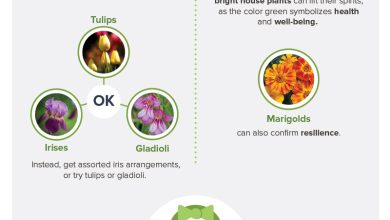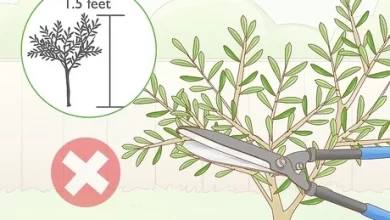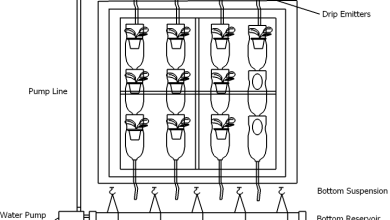14 Types of Orchards: [Characteristics and Operation]
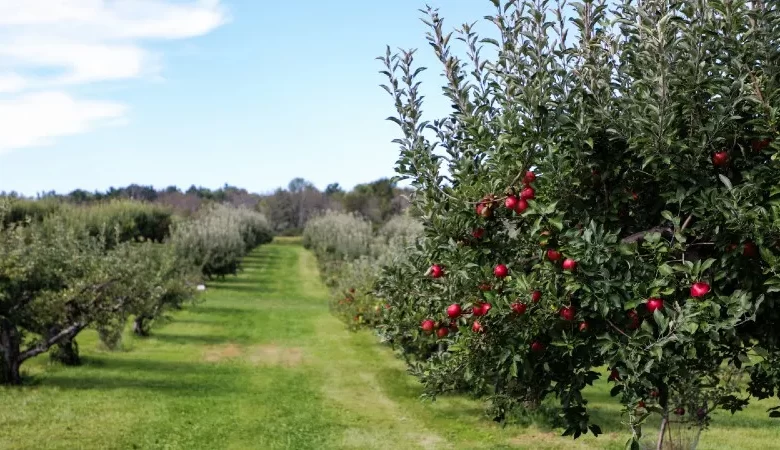
What types of gardens are there?
How about the city garden? The organic garden?
Below we will list various types of gardens, various forms of urban agriculture with different goals but many benefits.
14 Types of orchards that we can find
Private orchards seeking economic benefit
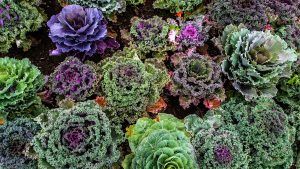 The owners of these gardens grow and sell the organic products harvested to customers (individuals, restaurants or consumer groups).
The owners of these gardens grow and sell the organic products harvested to customers (individuals, restaurants or consumer groups).
Rental gardens or leisure gardens also fall into this category: small plots are rented to urban gardeners on private land.
Users pay a monthly or annual fee for the garden, which generally includes services such as irrigation, tools needed for cultivation, and professional advice.
The difference between the two types is that the former are usually for profit and the latter generally do so for their own consumption and pleasure.
public gardens
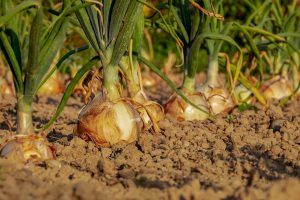 They are basically public gardens on allotted (or leased) land on public land managed by the state or municipality.
They are basically public gardens on allotted (or leased) land on public land managed by the state or municipality.
They are commonly used in organic farming and teaching sustainable technologies.
The competent authority is responsible for the management and maintenance of the facilities and determines the allocation, programming and specifications for the use of the plots.
In many cases, these public gardens are used by specific social groups, such as the elderly, the unemployed, children or people in a state of social exclusion.
The main objectives of municipal orchards and other public gardens are: the restoration and protection of urban spaces and local varieties, the practice and dissemination of organic agriculture, the use of education and training, and the establishment of social spaces, especially the socialization of the most vulnerable groups.
educational gardens
 There are several types of orchards whose purposes are environmental education, agricultural training or support for basic education.
There are several types of orchards whose purposes are environmental education, agricultural training or support for basic education.
Some examples are school gardens, gardens established in public facilities (universities, educational centers, etc.), or collective teaching gardens in which the people involved cooperate in maintaining the garden.
At the same time, these types of orchards organize free activities or courses designed for learning and practice.
In these orchards, the organization is responsible for teaching cultivation techniques to the participants and raising awareness about environmental issues.
They are becoming more fashionable in schools, where spaces are designated for the little ones (and not so little ones) to start with horticultural activities.
Healing or therapeutic gardens
 Work in orchards and gardening is another leisure and rehabilitation option for all types of patients and vulnerable groups.
Work in orchards and gardening is another leisure and rehabilitation option for all types of patients and vulnerable groups.
Therefore, these people increase the chances of distraction and at the same time promote their physical and mental health.
Therapists in all kinds of centers are increasingly using gardens and orchards as therapy, which is why they are increasingly common in nursing homes, social communication centers, hospital gardens and other health centers, prisons, schools of handicapped etc
These types of gardens have proven to have proven therapeutic purposes because they manage to keep people active, distract them and give them a goal to achieve (growth of their flowers, ornamental plants, indoor plants, etc…).
ornamental gardens

Gardens continue to be green and beautiful spaces, which is why more and more restaurants, hotels, houses and various public and private spaces use them for a dual purpose: food production and landscaping.
In addition to getting top quality fruits and vegetables, these establishments manage to beautify the place and make their customers enjoy being there more.
vertical gardens
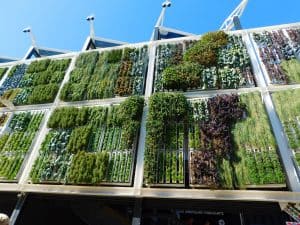
The vertical garden or orchard is one of the most fashionable decorative gardens.
Use containers on the walls, usually to build a garden on a special substrate.
In general, these types of vertical gardens are usually made from climbing plants. It has many benefits, such as providing greater insulation and also decorate the place considerably.
Along with aromatic plants, succulents are resistant and aesthetically attractive, which is why they are one of the most common options when creating a vertical garden.
hydroponic gardens
 Hydroponic crops are also in fashion. This is due to its relative simplicity, practicality and efficiency.
Hydroponic crops are also in fashion. This is due to its relative simplicity, practicality and efficiency.
Hydroponics or hydroponic agriculture is a method of growing plants using mineral solutions instead of agricultural soil.
The roots absorb a balanced nutrient solution that is soluble in water and has the chemical elements necessary for plant growth, the chemical elements can only grow in aqueous solutions or in inert media (such as washed sand, gravel, or perlite).
organic gardens
These types of orchards are characterized by being ecological.
What does this mean? The use of chemicals, pesticides and other products that can alter and/or harm the plants, as well as the crops obtained, are avoided at all costs.
Organic farming is based on this, as is permaculture.
Orchards with automatic irrigation
 As the extensions of land where an orchard is made are larger, it leads to the availability of more automated techniques in terms of irrigation systems.
As the extensions of land where an orchard is made are larger, it leads to the availability of more automated techniques in terms of irrigation systems.
We, who cultivate in a small area, automation through drip irrigation is essential for us (in addition to saving water).
But there are also orchards automatically irrigated by sprinkler, capillarity, blanket, etc…
Gardens according to shape
Garden layout is the technique of planting crops in a suitable system. There are different planting methods and therefore different arrangements.
Some of these types of arrangement are:
- square method.
- rectangular method.
- Quincunx method.
- triangle method.
- hexagon method.
- Contour or terrace method.
These systems may vary to some extent for different varieties.
land orchards
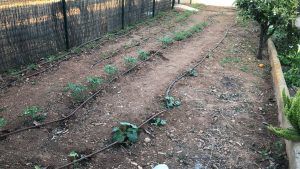 These types of orchards are the most common and the most commonly known.
These types of orchards are the most common and the most commonly known.
In this type of orchard, the substrate is always soil, or soil formed by the accumulation of eroded rocks of different particle sizes and organic matter.
Therefore, the land for these orchards depends on the geological conditions of the area.
If the rock is acidic (granite, quartz, basalt, etc.), the soil will be weakly acidic, and if it is alkaline (limestone, dolomite, loam, etc.), it will be alkaline.
If it is very close to the sea, or if there were salt lakes, ponds, or swamps in the past, the soil is likely to be saline-alkaline.
Farmers often try to improve soil characteristics by adding nutrients, organic matter, and other amendments (such as lime, wood ash, etc.).
To learn more: How to measure the pH of the soil.
Orchards using containers
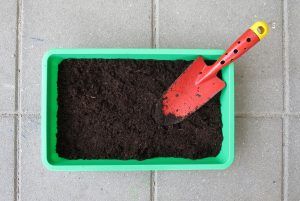
Container gardens are ideal for beginning gardeners, people who have limited space, or anyone who wants to dress up their porch or patio.
They can be planted with a single plant or with a combination of plants, depending on the look you want to achieve.
The most popular plants for pots are flowers, herbs, vegetables, herbs and succulents. Many gardeners change the plants they grow seasonally to ensure color is consistent throughout the year.
When choosing pots for a container garden, you’ll want to pick something that suits your taste, allows for good drainage, and is the right size and weight for where you plan to put it.
Garden pots are available in a wide variety of materials and styles, so you’re sure to find something you like.
Check out the following articles for tips and ideas for creating your own container garden.
In addition, it must be nutritious, so it usually contains compost, earthworm humus or other organic or mineral fertilizers.
Gardens in terraces
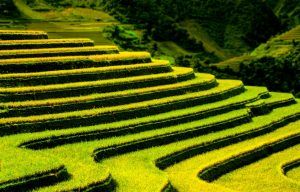
In this type of orchard, the growth space is a set of growth lines that prevent us from stepping on it. They are usually distributed at different height levels.
It can be accessed from the side to complete the job. The width of these beds is important to work comfortably: from a minimum of 60 cm to a maximum of 3 or 4 meters.
Constraint methods can be used to prevent stepping, which can be physical, ground-grown, or raised objects. If you want to do mechanical farming, you can give it width.
A method will be used to define them to prevent trampling, because trampling can be physical (rope, wood).
If we also opt for zero tillage, then we can opt for the roof design by Gaspar Caballero de Segovia, which integrates support plants in the cultivation area.
High beds: define them by increasing the growing area in relation to the aisle. The sides can be covered with some material to keep the soil or not (higher water consumption, more drainage).
fruit orchards
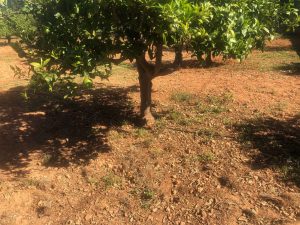 These types of orchards usually have large extensions and are usually used for economic benefit.
These types of orchards usually have large extensions and are usually used for economic benefit.
Very common in agriculture, fruit orchards include a large number of a particular fruit tree, or several. For example, in Spain orange or lemon orchards are common.
In Chile there are more and more avocado orchards. Vineyards, apple orchards, and pear orchards predominate in California.
Sources and bibliography consultations
-
The orchards: a strategy for the subsistence of peasant families, R Martínez Bustamante, JI Juan Pérez – Annals of Anthropology, 2005 – revista.unam.mx
-
[BOOK] The Garden: A Complete Guide, E Boffelli, G Sirtori – 2017 – books.google.com
-
[BOOK] The Garden, JM Rodríguez, R Díaz, M Gallardo, GA García, A Parra – 1989 – academia.edu
-
The scientific discourse in the infant stage in the context of the school organic garden, L Aragón, S Sánchez, JM Enríquez – Revista Eureka sobre …, 2021 – revista.uca.es
-
[PDF] SEED ORCHARD DESIGNS, RI Carmona, RV Lagos – researchgate.net
- https://www.mundohuerto.com/fundamentos/tipos-huertos
-
[PDF] Urbanizing with orchards, RP Asuero – Cimbra: Revista del Colegio de…, 2010 – s3.eu-central-1.amazonaws.com
-
Family gardens as an alternative to lower the costs of the family basket, Los Huertos Familiares – 2018 – repository.ug.edu.ec
-
Orchards and community gardens, NM Alonso – CF+ S Bulletin, 2014 – polired.upm.es

